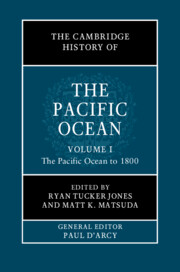Book contents
- The Cambridge History of the Pacific Ocean
- The Cambridge History of the Pacific Ocean
- The Cambridge History of the Pacific Ocean
- Copyright page
- Contents
- Figures
- Tables
- Contributors to Volume I
- Frontispiece
- General Editor’s Introduction
- Preface to Volume I
- Part I Rethinking the Pacific
- Part II Humans and the Natural World in the Pacific Ocean
- Part III Deep Time: Sources for the Ancient History of the Pacific
- Part IV The Initial Colonization of the Pacific
- 16 Pleistocene Voyaging and Maritime Dispersals in the Pacific
- 17 Early Maritime Navigation and Cultures in Coastal Southern China, Taiwan, and Island Southeast Asia, 6000–500 BCE
- 18 New Guinea’s Past: The Last 50,000 Years
- 19 Austronesian Colonization of the Pacific Islands, 1200 bce–1250 ce
- 20 Seafaring and Colonization in the Southern Ocean, 1000 ce–1850 ce
- 21 Polynesians in Central-South Chile
- Part V The Evolution of Pacific Communities
- Part VI Europe’s Maritime Expansion into the Pacific
- References to Volume I
- Index
16 - Pleistocene Voyaging and Maritime Dispersals in the Pacific
from Part IV - The Initial Colonization of the Pacific
Published online by Cambridge University Press: 11 November 2022
- The Cambridge History of the Pacific Ocean
- The Cambridge History of the Pacific Ocean
- The Cambridge History of the Pacific Ocean
- Copyright page
- Contents
- Figures
- Tables
- Contributors to Volume I
- Frontispiece
- General Editor’s Introduction
- Preface to Volume I
- Part I Rethinking the Pacific
- Part II Humans and the Natural World in the Pacific Ocean
- Part III Deep Time: Sources for the Ancient History of the Pacific
- Part IV The Initial Colonization of the Pacific
- 16 Pleistocene Voyaging and Maritime Dispersals in the Pacific
- 17 Early Maritime Navigation and Cultures in Coastal Southern China, Taiwan, and Island Southeast Asia, 6000–500 BCE
- 18 New Guinea’s Past: The Last 50,000 Years
- 19 Austronesian Colonization of the Pacific Islands, 1200 bce–1250 ce
- 20 Seafaring and Colonization in the Southern Ocean, 1000 ce–1850 ce
- 21 Polynesians in Central-South Chile
- Part V The Evolution of Pacific Communities
- Part VI Europe’s Maritime Expansion into the Pacific
- References to Volume I
- Index
Summary
Until quite recently, most scholars believed that boats, seafaring, and maritime2 dispersals were relatively late developments in human history, limited to the past 15,000 years or less.3 It now seems likely, however, that intentional Pleistocene voyaging played a role in the initial human colonization of at least three continents – greater Australia (aka Sahul), North America, and South America – as well as several island archipelagoes, including portions of island Southeast Asia (ISEA), the Ryukyus, and Near Oceania. These dispersals may have been facilitated by millennia of experimenting and refining boat technology along the ‘Southern Dispersal Route’, which many scholars believe early modern humans followed as they moved eastward out of Africa, along the shores of southern Asia and the northwest Pacific.4 If true, the nearshore marine and estuarine ecosystems of southern Asia and ISEA may have been a nursery for Late Pleistocene seafaring,5 as well as a springboard for the later Holocene maritime dispersals that led humans to explore and colonize the remote Pacific archipelagoes of Micronesia, Melanesia, and Polynesia.6
- Type
- Chapter
- Information
- The Cambridge History of the Pacific Ocean , pp. 369 - 380Publisher: Cambridge University PressPrint publication year: 2023



